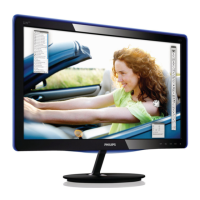
Do you have a question about the Philips 227E3LHSU/01 and is the answer not in the manual?
| Screen Size | 21.5 inches |
|---|---|
| Resolution | 1920 x 1080 pixels |
| Panel Type | TN |
| Response Time | 5 ms |
| Brightness | 250 cd/m² |
| Contrast Ratio | 1000:1 |
| Aspect Ratio | 16:9 |
| Color Support | 16.7 million colors |
| Connectivity | HDMI, VGA |
Covers general warnings, operation, and maintenance safety guidelines for monitor usage.
Details picture/display, connectivity, convenience features, and stand specifications.
Provides information on power usage across different operating modes and energy star ratings.
Illustrates the main functional blocks and interconnections within the LCD monitor.
Covers basic instructions for turning on/off and using front panel control buttons.
Explains how to access and navigate the on-screen display menu for adjustments.
Details specifications and pinouts for D-sub, DVI, and HDMI input connectors.
Lists supported resolutions, preset modes, and vertical frequencies for optimal display.
Defines acceptable levels and types of pixel defects for warranty claims.
Describes common visual failures and phenomena that can occur with LCD panels.
Presents block diagrams illustrating the functional connections of internal boards.
Provides detailed circuit schematics for the scaler and power boards.
Shows the physical component placement on the scaler and power board PCBs.
Outlines the step-by-step process for disassembling the monitor.
Provides diagnostic flowcharts for common issues like no power, no video, DIM, or color problems.
Details the steps for connecting, installing drivers, and updating firmware via ISP.
Explains the procedure for writing EDID data and serial numbers to the monitor.
Covers equipment setup, connection, and the process for adjusting color and brightness.
Details how to measure and confirm color temperature against specifications.
Lists part numbers, locations, and descriptions for recommended and spare parts.
Provides a general overview, foreword, and specifications for the LCD panel.
Details interface signals, timing, OSD functions, power management, and I/O specifications.
Covers brightness, color temperature adjustment, cosmetic details, and dimensions.
Outlines packaging, shipping standards, and environmental operating conditions.
Covers general safety, implosion, X-radiation, leakage current tests, and parts replacement.
